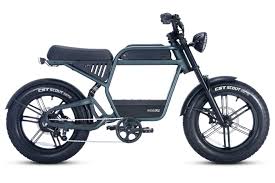
Electric bikes, commonly referred to as e-bikes, have become a popular and transformative mode of transportation in recent years. Combining the convenience and accessibility of traditional bicycles with the power and efficiency of electric motors, e-bikes are revolutionizing the way people commute, exercise, and explore their surroundings. This article delves into the various aspects of electric bikes, including their history, benefits, types, and the future of e-bike technology.
Table of Contents
ToggleA Brief History of Electric Bikes
The concept of electric bike dates back to the late 19th century. In 1895, Ogden Bolton Jr. patented an electric bicycle with a hub motor mounted in the rear wheel. Although the idea was innovative, it wasn’t until the late 20th and early 21st centuries that technological advancements made e-bikes more practical and affordable for the average consumer. The development of lightweight lithium-ion batteries, efficient electric motors, and improved electronic control systems have all contributed to the surge in e-bike popularity.
Benefits of Electric Bikes
Electric bikes offer numerous advantages over traditional bicycles and other forms of transportation. Here are some key benefits:
- Enhanced Mobility and Accessibility: E-bikes provide an accessible transportation option for people of all ages and fitness levels. The electric assist helps riders conquer hills, long distances, and headwinds with ease, making cycling a viable option for commuting and leisure.
- Environmental Impact: E-bikes are an eco-friendly alternative to cars and motorcycles. They produce zero emissions and have a significantly lower carbon footprint compared to fossil fuel-powered vehicles. As cities strive to reduce air pollution and traffic congestion, e-bikes play a crucial role in promoting sustainable urban mobility.
- Cost-Effectiveness: While the initial investment in an e-bike might be higher than a traditional bicycle, the long-term savings are substantial. E-bikes have lower maintenance costs, no fuel expenses, and often qualify for government incentives or subsidies aimed at promoting green transportation.
- Health Benefits: E-bikes encourage physical activity by providing a gentle form of exercise. Riders can choose the level of electric assistance, allowing them to pedal as much or as little as they desire. This flexibility makes it easier for people to integrate cycling into their daily routines, leading to improved cardiovascular health and overall well-being.
- Reduced Travel Time: In urban areas plagued by traffic jams, e-bikes offer a faster and more efficient way to navigate through congested streets. Commuters can often reach their destinations quicker than by car or public transportation, especially during peak hours.
Types of Electric Bikes
E-bikes come in various styles and configurations to suit different needs and preferences. Some common types include:
- City E-Bikes: Designed for urban commuting, city e-bikes feature comfortable seating, upright handlebars, and integrated lights and fenders. They are ideal for short to medium-distance rides on paved roads.
- Mountain E-Bikes: These e-bikes are built for off-road adventures, featuring rugged frames, suspension systems, and knobby tires. The electric assist helps riders tackle steep trails and rough terrains with ease.
- Folding E-Bikes: Perfect for commuters with limited storage space, folding e-bikes can be easily collapsed and stored in small apartments, offices, or public transportation. They are lightweight and portable, making them convenient for multi-modal travel.
- Cargo E-Bikes: Designed to carry heavy loads, cargo e-bikes are equipped with sturdy frames, large storage areas, and powerful motors. They are ideal for transporting groceries, children, or other bulky items.
- Fat Tire E-Bikes: Featuring oversized tires, fat tire e-bikes provide excellent stability and traction on sand, snow, and uneven surfaces. They are popular among adventure seekers and outdoor enthusiasts.
The Future of Electric Bikes
The future of electric bikes looks promising, with continuous advancements in technology and growing global interest in sustainable transportation. Here are some trends and developments to watch for:
- Battery Technology: Researchers are constantly working on improving battery life, reducing charging times, and enhancing the overall efficiency of e-bike batteries. This will lead to longer ranges and more convenient usage for riders.
- Integration with Smart Technology: E-bikes are becoming increasingly connected, with features such as GPS navigation, smartphone integration, and real-time performance monitoring. These smart features enhance the riding experience and provide valuable data for maintenance and optimization.
- Expansion of Infrastructure: As e-bikes gain popularity, cities are investing in bike-friendly infrastructure, including dedicated bike lanes, charging stations, and secure parking facilities. This infrastructure supports the growth of e-bike usage and ensures rider safety.
- Customization and Personalization: Manufacturers are offering more customization options, allowing riders to tailor their e-bikes to their specific needs and preferences. This includes adjustable power levels, modular components, and personalized aesthetics.
In conclusion, electric bikes represent a significant shift in the way we think about transportation. With their numerous benefits, diverse range of styles, and promising future developments, e-bikes are poised to play a crucial role in creating a more sustainable, efficient, and enjoyable mode of travel for people around the world.